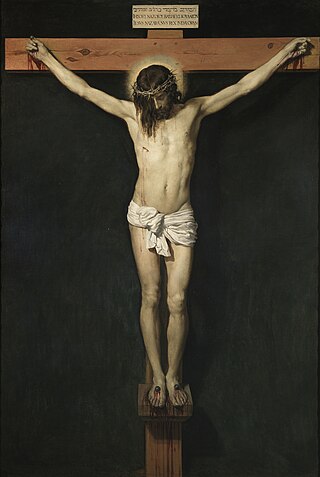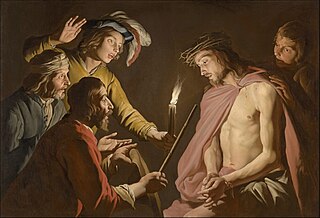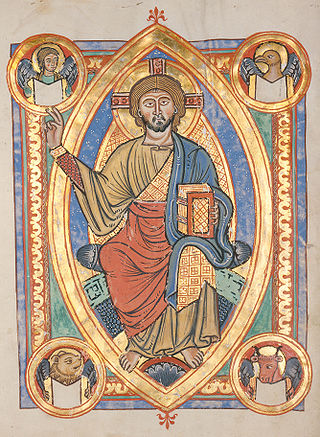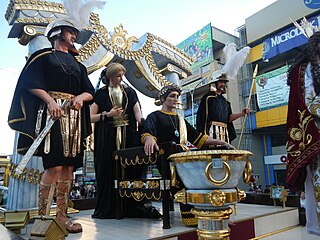
A crucifix is a cross with an image of Jesus on it, as distinct from a bare cross. The representation of Jesus himself on the cross is referred to in English as the corpus. The crucifix emphasizes Jesus' sacrifice, including his death by crucifixion, which Christians believe brought about the redemption of mankind. Most crucifixes portray Jesus on a Latin cross, rather than a Tau cross or a Coptic cross.

Crucifixion is a method of capital punishment in which the condemned is tied or nailed to a large wooden cross, beam or stake and left to hang until eventual death. It was used as a punishment by the Persians, Carthaginians, and Romans, among others. Crucifixion has been used in some countries as recently as the early 20th century.

Good Friday is a Christian holy day observing the crucifixion of Jesus and his death at Calvary. It is observed during Holy Week as part of the Paschal Triduum. It is also known as Black Friday, Holy Friday, Great Friday, Good Friday of the Passion of the Lord,Great and Holy Friday.

The Passion is the short final period before the death of Jesus, described in the four canonical gospels. It is commemorated in Christianity every year during Holy Week.

Holy Week is the most sacred week in the liturgical year in Christianity. For all Christian traditions, it is a moveable observance. In Eastern Christianity, which also calls it Great Week, it is the week following Great Lent and Lazarus Saturday, starting on the evening of Palm Sunday and concluding on the evening of Great Saturday. In Western Christianity, Holy Week is the sixth and last week of Lent, beginning with Palm Sunday and concluding on Holy Saturday.
The Penitent Thief, also known as the Good Thief, Wise Thief, Grateful Thief, or Thief on the Cross, is one of two unnamed thieves in Luke's account of the crucifixion of Jesus in the New Testament. The Gospel of Luke describes him asking Jesus to "remember him" when Jesus comes into his kingdom. The other, as the impenitent thief, challenges Jesus to save himself and both of them to prove that he is the Messiah.

The Stations of the Cross or the Way of the Cross, also known as the Way of Sorrows or the Via Crucis, are a series of images depicting Jesus Christ on the day of his crucifixion and accompanying prayers. The stations grew out of imitations of the Via Dolorosa in Jerusalem, which is a traditional processional route symbolising the path Jesus walked to Mount Calvary. The objective of the stations is to help the Christian faithful to make a spiritual pilgrimage through contemplation of the Passion of Christ. It has become one of the most popular devotions and the stations can be found in many Western Christian churches, including those in the Roman Catholic, Lutheran, Anglican, and Methodist traditions.

San Pedro Cutud is a barangay in the city of San Fernando, Pampanga province in the Philippines, approximately 70 kilometers (43 mi) north of Manila.

In Catholic tradition, the Five Holy Wounds, also known as the Five Sacred Wounds or the Five Precious Wounds, are the five piercing wounds that Jesus Christ suffered during his crucifixion. The wounds have been the focus of particular devotions, especially in the late Middle Ages, and have often been reflected in church music and art.

The swoon hypothesis is any of a number of ideas that aim to explain the resurrection of Jesus, proposing that Jesus did not die on the cross, but merely fell unconscious ("swooned"), and was later revived in the tomb in the same physical body. According to the proponents of the swoon hypothesis, the appearances of the risen Jesus to his disciples following his physical resurrection from the dead three days in the tomb were merely perceived to be resurrection appearances by his followers; proponents of the swoon hypothesis believe that Jesus allegedly fell unconscious ("swooned") on the cross, survived the crucifixion, and then regained enough strength to appear before them while he was still alive.

The instrument of Jesus' crucifixion is generally taken to have been composed of an upright wooden beam to which was added a transom, thus forming a "cruciform" or T-shaped structure.

The Pampanga Sugar Development Company built the first Filipino-financed sugar central in Pampanga, Philippines. It was established in 1921 by several local families in Pampanga. It is the oldest running mill in the province.

The Scriptural Way of the Cross or Scriptural Stations of the Cross is a modern version of the ancient Christian, especially Catholic, devotion called the Stations of the Cross. This version was inaugurated on Good Friday 1991 by Pope John Paul II. The Scriptural version was not intended to invalidate the traditional version. Rather it was meant to add nuance to an understanding of the Passion.

Holy Week is a significant religious observance in the Philippines for the Catholic majority, the Iglesia Filipina Independiente or the Philippine Independent Church, and most Protestant groups. One of the few majority Christian countries in Asia, Catholics make up 78.8 percent of the country's population, and the Church is one of the country's dominant sociopolitical forces.

The crucifixion of Jesus was the execution by crucifixion of Jesus of Nazareth in 1st-century Judaea, most likely in AD 30 or AD 33. It is described in the four canonical gospels, referred to in the New Testament epistles, attested to by other ancient sources, and is broadly accepted as one of the events most likely to have occurred during his life. There is no consensus among historians on the details.

Crucifixions and crucifixes have appeared in the arts and popular culture from before the era of the pagan Roman Empire. The crucifixion of Jesus has been depicted in a wide range of religious art since the 4th century CE, frequently including the appearance of mournful onlookers such as the Virgin Mary, Pontius Pilate, and angels, as well as antisemitic depictions portraying Jews as responsible for Christ's death. In more modern times, crucifixion has appeared in film and television as well as in fine art, and depictions of other historical crucifixions have appeared as well as the crucifixion of Christ. Modern art and culture have also seen the rise of images of crucifixion being used to make statements unconnected with Christian iconography, or even just used for shock value.

Holy Week in Mexico is an important religious observance as well as important vacation period. It is preceded by several observances such as Lent and Carnival, as well as an observance of a day dedicated to the Virgin of the Sorrows, as well as a Mass marking the abandonment of Jesus by the disciples. Holy Week proper begins on Palm Sunday, with the palms used on this day often woven into intricate designs. In many places processions, Masses and other observances can happen all week, but are most common on , Good Friday, Holy Saturday and Easter Sunday, with just about every community marking the crucifixion of Jesus in some way on Good Friday. Holy Saturday is marked by the Burning of Judas, especially in the center and south of the country, with Easter Sunday usually marked by a Mass as well as the ringing of church bells. Mexico's Holy Week traditions are mostly based on those from Spain, brought over with the Spanish conquest of the Aztec Empire, but observances have developed variations in different parts of the country due to the evangelization process in the colonial period and indigenous influences. Several locations have notable observances related to Holy Week including Iztapalapa in Mexico City, Taxco, San Miguel de Allende and San Luis Potosí.

Good Friday processions in Baliuag or Holy Week procession in Baliuag, Bulacan is an event taking place in Holy Week, in a traditional Roman Catholic culture of the St. Augustine Parish Church of Baliuag.

Crucifixion in the Philippines is a devotional practice held every Good Friday, and is part of the local observance of Holy Week. Devotees or penitents called magdarame in Kapampangan willingly have themselves crucified to reenact Jesus Christ's suffering and death, while related practices include carrying wooden crosses, crawling on rough pavement, and self-flagellation. Penitents consider these acts to be mortification of the flesh, and undertake these to ask forgiveness for sins, to fulfil a panatà, or to express gratitude for favours granted. In the most famous case, Ruben Enaje drives four-inch nails into both hands and feet and then he is lifted on a wooden cross for around five minutes.

Lilia Garcia Pineda, also known as Nanay Baby, is a Filipino politician who has been serving as Vice Governor of Pampanga under her son Dennis Pineda since 2019. She previously served as Governor of the province from 2010 until 2019 as Mayor of Lubao from 1992 until 2001. Pineda was a close ally of Gloria Macapagal-Arroyo during the latter's presidency from 2001 to 2010.

















